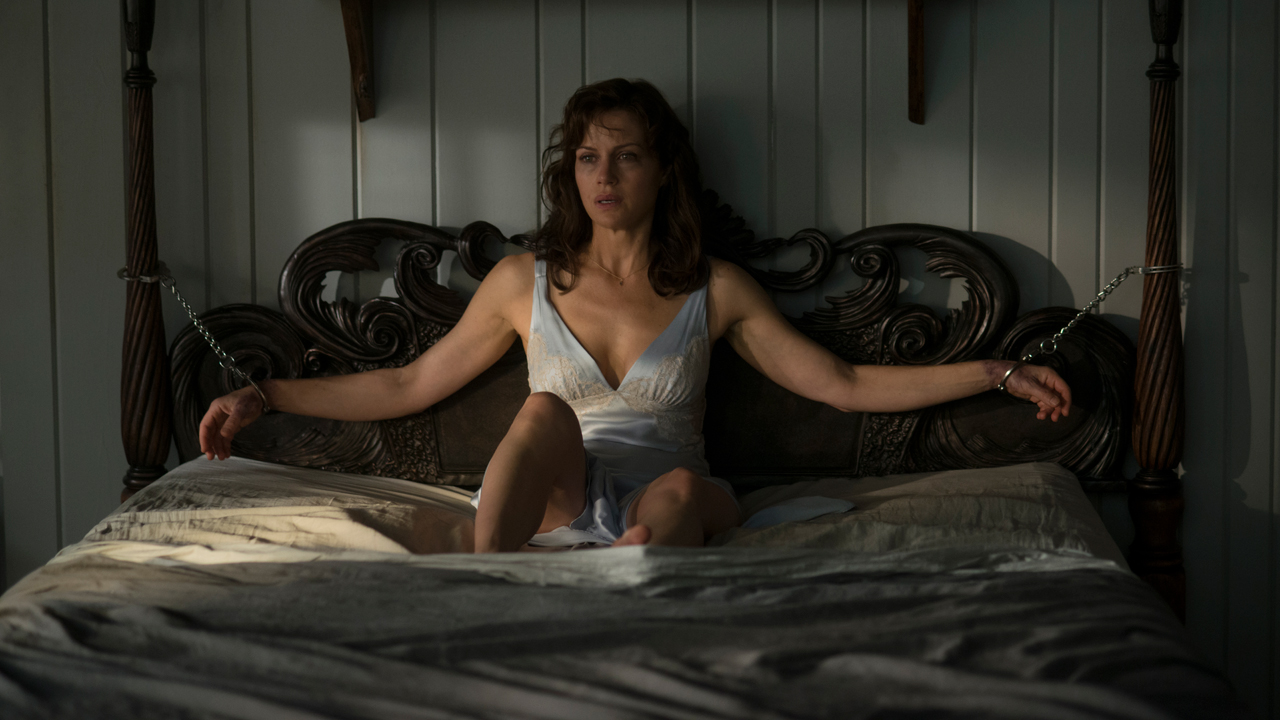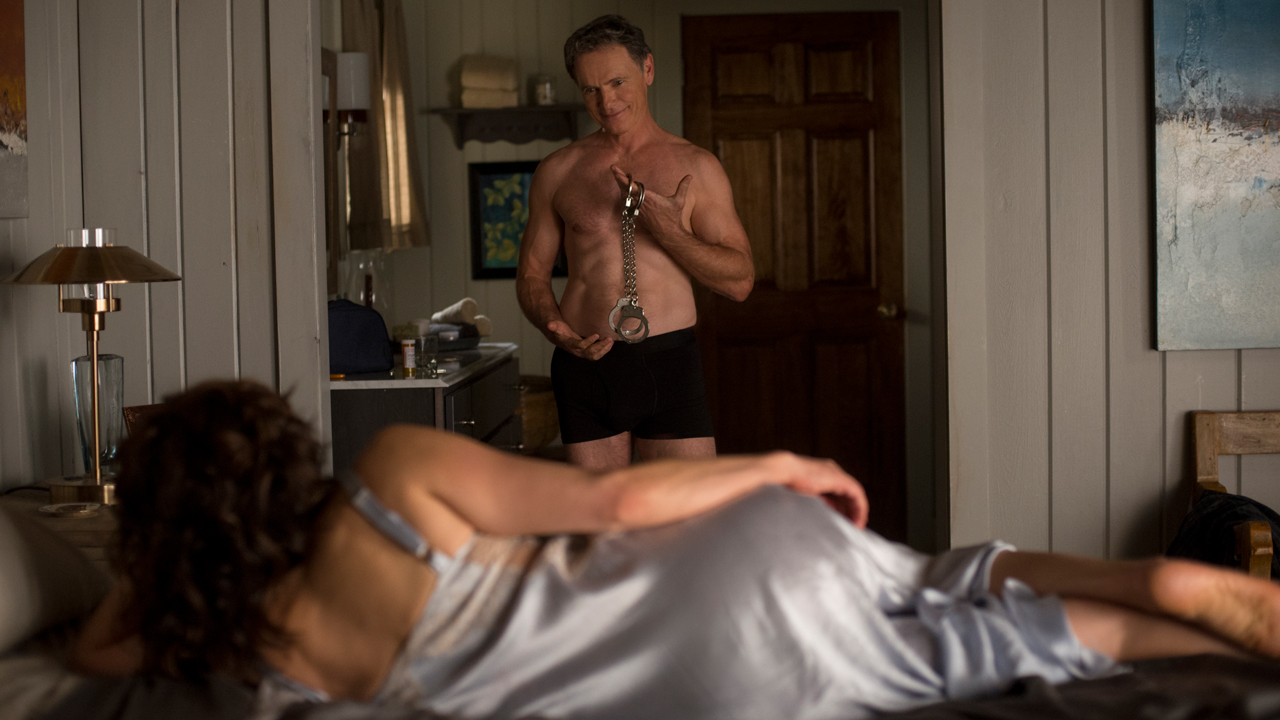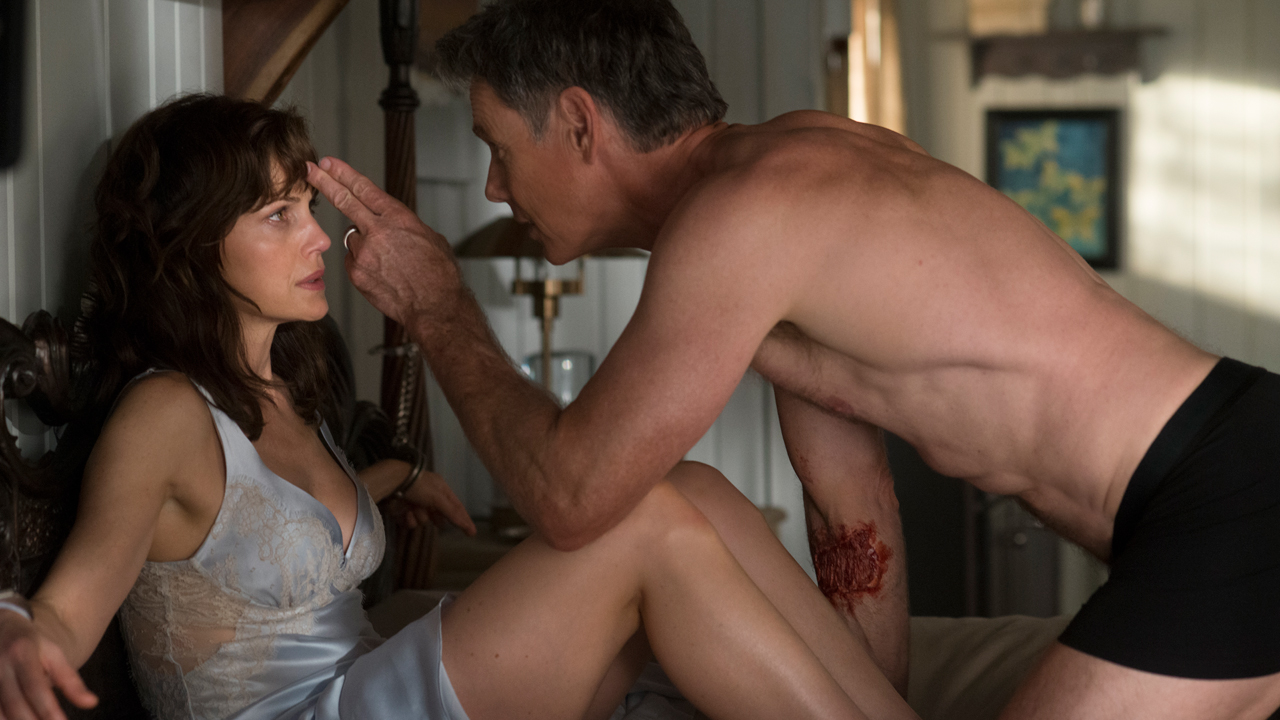Adapting Stephen King's Gerald's Game: How The 2017 Movie Took An Unfilmable Book And Made A Phenomenal Adaptation
Before Doctor Sleep, Mike Flanagan brought us the brilliance of Gerald's Game.

For a long time, Stephen King didn’t want to give up Gerald's Game. As history has shown, the author is generally excited to sell the movie rights to his books and see what filmmakers can come up with, but his 1992 novel about a woman trying to stay alive while handcuffed to a bed in a remote lake house was an exception. He wanted to take a crack at it himself.
In a May 2002 interview with Tony Magistrale for Hollywood’s Stephen King, he said,
Castle Rock made a great feature out of Misery because it's short and all in one place. The same thing is true of Gerald's Game, which is a property that I have decided to hold on to. We've had a lot of offers on Gerald's Game, but I have refused. I'm thinking eventually, if I get a chance in my retirement, I want to write the screenplay for Gerald's Game.
A dozen years later, retirement still wasn’t on the horizon for Stephen King… and into the picture stepped writer/director Mike Flanagan. The filmmaker was so passionate about the idea of making a Gerald's Game adaptation that he used to bring a copy of the novel with him to pitch meetings, just waiting for the conversation to turn to the subject of “dream projects.”
Unfortunately, his enthusiasm wasn’t enough to sell anybody on the idea. In a 2017 interview with GQ, Flanagan explained that people who were familiar with the book would instantly tell him that the material was unfilmable, and those to whom he pitched the plot deemed it “not a movie.”
What changed things was the relationship that Mike Flanagan forged with Netflix. Flanagan’s film Hush was a great all-around success when it hit the streaming service in April 2016, and the company was passionate about what the filmmaker was passionate about:
Netflix was after Hush and because of how well that did, they said, ‘What do you have that you're really excited about?’ We gave it to them and kept expecting the response it's gotten a lot of times over the years... It was a relief that Netflix wanted to make the same movie we wanted to make.
With a screenplay co-written by Mike Flanagan and Jeff Howard, and Carla Gugino and Bruce Greenwood in the lead roles, Gerald's Game started production in the fall of 2016, and it ended up being released in the middle of the King renaissance of 2017 – less than three weeks after the blockbuster opening of Andy Muschietti’s IT: Chapter One. The big screen release cast a massive shadow, but it’s nonetheless one of the best King movies of all time, and I get into why in this week’s Adapting Stephen King.

What Gerald's Game Is About
Like the story behind Misery, Gerald's Game began with a dream on an airplane… and the timing was quite inconvenient. It was the summer of 1990, and he was planning on using the season to relax and step away from writing, but the will of his muse proved far too powerful.
Your Daily Blend of Entertainment News
In a September 1991 interview with Wallace Stroby, he recounted how the high-concept idea came to him midflight and how he felt compelled to utilize it:
With Gerald's Game, it was like an unplanned pregnancy. I was on an airplane going down to New York – I'm not a very good flyer but the air was very mellow that day – and I fell asleep. I had a dream with something salvageable from it, and I said: ‘Oh, that's wonderful, what a great idea. I must write it.’ Not because it was a whole story but because it was one of these situations that's so interesting that you figure if you start to write it, things will suggest themselves.
Beyond Stephen King’s desire to take a step back away from his work, the other conflict that existed was the planned release of Dolores Claiborne, which, according to Bev Vincent’s Stephen King: A Complete Exploration Of His Work, Life, And Influences, was already announced to come out in 1992. Gerald's Game poured out of him first, and when it did, the author pondered the idea of publishing the two stories as one book. He told Stroby in 1991,
I thought for a while that I could put this thing together with Dolores Claiborne and do one book. Sometimes that happens. I've done that before with Different Seasons and Four Past Midnight, where the stories actually seemed to group together, although they were novels. But these things were a little bit longer and just would not be harnessed together. So eventually I decided to do them separately. Since I went to work on Gerald's Game first, I decided to go with that one.
The two novels did come out separately, as Gerald's Game was published in May 1992 and Dolores Claiborne hit stores in November the same year, but they are stories that are still deeply and purposefully linked. Both books contain disturbing events that transpire under the darkness of the total eclipse on July 20, 1963, and the respective female protagonists experience a vision of the other.
Gerald's Game’s protagonist is Jessie Burlingame, and the titular Gerald is her husband – with whom she travels to a lake house off-season to try and reinvigorate their marriage. Gerald has a desire to play out a bondage scenario, and he purchases pairs of police-grade handcuffs so that he can trap his wife against the bed’s reinforced headboard. The role playing ends up triggering Jessie, and when she tries to get him to stop and he refuses, she is forced to give him two swift kicks to the guts and the nuts. This is not good for the out-of-shape hubby, who proceeds to have a heart attack and die, leaving Jessie trapped.
A fight for survival begins – her mind fracturing as she hallucinates versions of herself and key people from her past in the room with her – and part of escaping means finally confronting the horrific trauma from her past that she has kept secret her entire adult life.

How Mike Flanagan's Gerald's Game Differs From Stephen King's Book
As you have probably picked up, Mike Flanagan and co-writer Jeff Howard were dedicated to making Stephen King’s Gerald’s Game and not a compromised studio version – and that’s exactly what they accomplished. It doesn’t soften the material in any way, and doesn’t contain any needless “extra” scenes the break away from the action with Jessie (Carla Gugino) in the bedroom – a la the storyline with Richard Farnsworth’s Buster in Rob Reiner’s Misery.
That’s not to say that it doesn’t make some notable and significant changes. On the former front, there is the setting, which is moved from Maine to Alabama/Louisiana (it doesn’t have any of the Castle Rock references from the book), and the story is modernized – which means including a cell phone that is out of Jessie’s reach and the glass of water being put on the headboard because Gerald (Bruce Greenwood) pops a Viagra pill (which didn’t exist in 1992).
In regards to the significant changes, the biggest deviation from the source material in Gerald’s Game is the depiction of Jessie’s hallucinations. The protagonist speaks to a number of different “people” during her crisis in the book – including a puritanical version of herself named Goody Burlingame; her younger self, nicknamed Punkin; her former college roommate Ruth Neary; and her former therapist, Nora Callighan. Flanagan and Howard brilliantly simplify things: the voices in the room become Jessie’s mental version of Gerald and herself.
There are additionally a few alterations made in the third act. One is the source of inspiration for Jessie to cut herself with the water glass, as the flashback at the dinner scene where she crushes a glass in her hand replaces a memory in the book of young Jessie needing to handle eclipse lenses with oven mitts to avoid cutting herself. Additionally, the letter that she ends up writing is to her younger self instead of to Ruth Neary – which is obviously a change that is part of what’s discussed in the previous paragraph.
The most substantial change in the ending is Jessie’s confrontation with Carel Struycken's Raymond Andrew Joubert a.k.a. The Moonlight Man (who is nicknamed Space Cowboy in the novel). Stephen King’s version is far more aggressive, as she spits in the monsters face, but Mike Flanagan and Jeff Howard have her be above that and simply remark that he is smaller than she remembers (a callback to her perspective on her family’s lake house during the eclipse flashback).

Is It Worthy Of The King?
The work of Stephen King is an essential part of Mike Flanagan's filmmaking DNA. In 2006, he directed the short Oculus: Chapter 3 - The Man With The Plan, and while it’s primarily known for being the source material on which his breakout 2013 feature Oculus is based, the writer/director told The Kingcast in 2020 that he basically made it as a legally allowable adaptation of King’s short story “1408.” His attempt to make an official version as part of the Dollar Baby Program was thwarted (the rights were already owned by Dimension Films), so he put his own spin on the haunting tale – and it ended up starting the career path he has continued on to this day.
Flanagan’s love for Stephen King and Gerald's Game is palpable through what he has made, and it makes the Netflix movie a standout in the long history of King adaptations. More than it just being an incredibly faithful interpretation of what’s on the page, it’s a blissful experience for Constant Readers because of its whole embrace of the author’s work. Director Taylor Hackford and screenwriter Tony Gilroy notably don't include any references to Gerald's Game in 1995’s Dolores Claiborne, but Flanagan not only keeps the connective tissue between the books intact with his film (namely Jessie recounting her vision of Dolores on the day of the eclipse), but he even throws in a Dark Tower reference for good measure, as the hallucination of Gerald at one point tells his widow, “All things serve The Beam.”
Watching the movie, you actually wonder how the book was ever deemed unadaptable, as it’s a richly crafted cinematic experience that only escalates in intensity and respectfully treats sensitive and heavy subject matter without a trace of exploitation. But that’s just indicative of the magic that Mike Flanagan has performed. Every change he makes improves on what Stephen King originally wrote – and, of course, it demands mention that Carla Gugino delivers the most impressive and remarkable performance of her career. She makes you feel every ounce of Jessie’s emotional and physical pain, turning Gerald's Game into a visceral and powerful experience long before the notorious degloving scene that is impossible to watch without significant squirming in one’s seat. (Additionally, Henry Thomas’ monstrous scene of emotional manipulation with Chiara Aurelia as young Jessie is as chilling and horrifying as any moment in any King film, including the degloving.)
Stephen King hyped the film for fans seven months prior to its arrival on Netflix, teasing fans with a Tweet in February 2017 calling the adaptation “Horrifying, hypnotic, terrific” – and it lives up to the hype in every respect. It’s a remarkable achievement… and yet somehow it is still only the second best King adaptation that Mike Flanagan has made (but I’ll get more into that with my column scheduled for December 14).

How To Watch Mike Flanagan’s Gerald's Game
There’s good news and bad news when it comes to watching Mike Flanagan’s Gerald's Game: the good news is that it’s permanently available to watch for anybody with a Netflix subscription; the bad news is that’s literally the only way to watch it. It’s not available for digital purchase or rental on any other platform, and despite some pleading from Mike Flanagan, there isn’t any sign that it will be getting a Blu-ray release. Hopefully that is a situation that one day changes and Constant Readers will be able to add it to their Ultimate Stephen King Collections. In the meantime, find Gerald's Game streaming on Netflix.
Covering the sixth and final project that was released in 2017, next week’s Adapting Stephen King column will be taking a close look at Zak Hilditch's 1922 – the second King movie made as a Netflix original film and released just weeks after Gerald's Game. Look for my feature in CinemaBlend’s Streaming section on Wednesday, and click through the banners below in the meantime to discover all of the previous installments.







Eric Eisenberg is the Assistant Managing Editor at CinemaBlend. After graduating Boston University and earning a bachelor’s degree in journalism, he took a part-time job as a staff writer for CinemaBlend, and after six months was offered the opportunity to move to Los Angeles and take on a newly created West Coast Editor position. Over a decade later, he's continuing to advance his interests and expertise. In addition to conducting filmmaker interviews and contributing to the news and feature content of the site, Eric also oversees the Movie Reviews section, writes the the weekend box office report (published Sundays), and is the site's resident Stephen King expert. He has two King-related columns.
